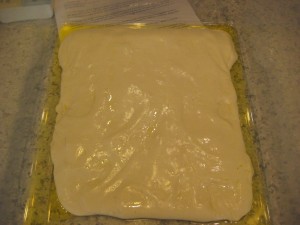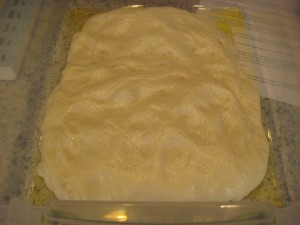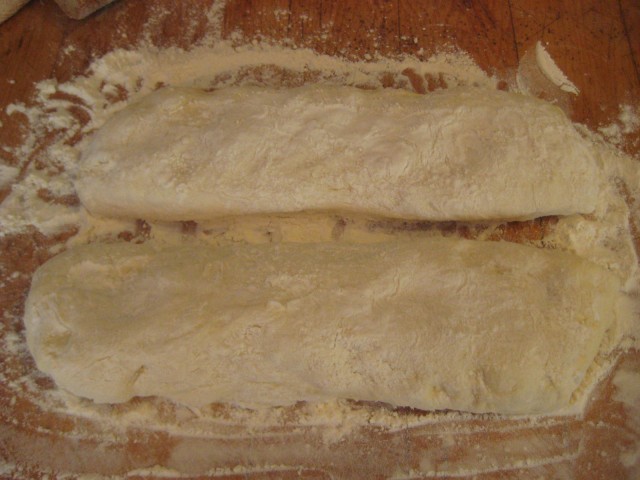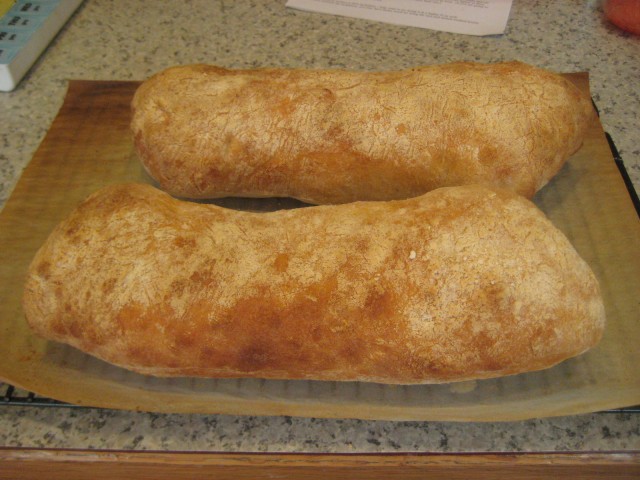
I love the concept of making sourdough breads! But for me, it’s one of those life challenges that comes up and bites me in the ass – and frankly, I don’t know if that bite is a message to stay away, a wake-up call to pay more attention, or just a punishment for screwing up again – whatever, sourdough is about as scientific as baking gets, and it really does force you to learn more than you wanted to know about the science of sourdough before it will let you feel the satisfaction of success.
I have had a really bad problem with sourdough consistency. And I’m never sure if it’s me that’s inconsistent, or my sourdough starters – I think at least part of my dilemma is that I didn’t understand how sourdough did its magic. I’ve been of the mind that in order to make a successful sourdough loaf, your starter needed to be really active, and you needed to use lots of it! But I recently learned another sourdough secret that has opened new avenues of understanding for me, and promises to make me a better baker in the process. Maybe it’s only a secret to me, but now I realize that you can actually start with only a tiny amount of sourdough starter, and if you give it enough time, you will have a high and light rise as a result. Makes one feel like a complete dummy.
I don’t know why this should have come as such a surprise, because I know that baker’s yeast will do exactly that – give it enough time, and a pinch will do exactly, in 24 hours, what 3 tablespoons will do in an hour!(but w/o that over-powering yeasty taste) I guess I was having trouble recognizing the similarity between commercial yeast fungi/bacteria, and a sourdough yeast fungi/bacteria. Oh well.

Dough first entering proofing tub
Another emerging kernel of knowledge is how to successfully work with a very wet dough – this always scared the be-jezus out of me, and I think many other bakers. But I’ve been using one of those Wal-Mart storage containers (what a baker might call a “dough tub”, but my Wal-Mart calls them “sweater storage boxes”!) to hold the wet dough during proofing, and I’m simply struck dumb with fascination at the wonders that occur in that plastic box!
Well, both of these new pieces of knowledge come together in the making of ciabatta, and in fact, it is during some recent attempts at making ciabatta that the above bits of knowledge slowly sank in. I recently spent a lot of time on a baking forum, danlepard.com, (Dan is a British baking celebrity) particularly working through a two year discussion thread on ciabatta. It’s not an overstatement to say that this one thread is a total education in and by itself! Took me the better part of a week – and I enjoyed the hell out of it. And as a result, I’ve baked the best ciabatta of my life, which coincidentally was the wettest sourdough I’ve ever worked with.

A fully matured proofing
This recipe, which comes from the above mentioned forum thread, via forum members, Pab and Brassmoose – they both worked to bring this formula to a finished state – and I only felt it right to use Pab’s own recipe post and words to share this goodie with you. (anything below in parentheses is my comment)

Cut, Floured, and Ready for Baking
Ciabatta
from danlepard.com
per Pab and Brassmoose
(76% hydration)
The biga:
400g bread flour
200g water
1 teaspoon of white leaven (A teaspoon! Blows my mind!)
Mixed in stand mixer until I had a smooth dough and had developed the gluten a little (This is extraordinarily dry – I will not risk my KA on this – easy enough to do by hand in a bowl – once it comes together in the bowl, knead on your board for five minutes). Oiled a bowl and put the biga in it. I put this together in the morning, expecting it to triple after 24 hours. After 12 hours, it had easily tripled, so I had to put it in the fridge over night. Your leaven may be differently active. (I mixed at night, left it at room temp, and the biga was ready by noon the next day.)
Let it warm to room temp, then mix in the stand mixer:
100g bread flour
90g water
600g biga (above) in chunks
until smooth. Allow to rest (autolyze) 20 minutes.
Separately dissolve 1.5 t finely ground sea salt in 90g water
Then slowly mix this into the dough in mixer. Raised speed to medium and mixed with hook 15 minutes. After 15 min the dough is still very soupy, but it clings to the hook during mixing – that is, it doesn’t stick to the bowl of the mixer anymore. (mine never came away from bowl bottom.)
Scraped into oiled bowl. At this point, things happened very quickly: it doubled in almost no time – 1 hour. After an hour, I folded it as best I could on an oiled surface and put it back in the bowl. (I used my large plastic tub, well oiled – worked a charm! I gave it 2 hours, with folds and stretches at the ½ hour) I also turned on the oven at this point, 425F. After another half hour, I dusted a large wood board heavily with flour and turned the dough onto it. Dusted the dough pretty heavily so I could touch it without it sticking to my fingers. Then divided in half. Stretched into long pieces and cut in half to make four 12-inch pieces. (I made only two loaves – not enough dough for 4) Dusted them again with flour. Let these rest two to a floured baking sheet for half an hour, then baked 18-20 minutes, until they were golden.
C’est tout.

Lovely bread, and easy to work with if you use the oiled plastic tub.
I’ll be submitting this to Susan @ Wild Yeast for the upcoming YeastSpotting collection.


Don’t you love working with wet dough (now)? This one gave you a couple of beautiful loaves with fantastic open crumb!
You are too kind, Susan – but it does feel good when everything goes right – Magic happens!
Gorgeous crumb! Bravo!
Yes! Love working with ‘wet’ dough and making ciabatta. I’ve only ever done it with a yeast biga or poolish, but looking at your loaves and reading the blog entry…I nipped home at lunchtime just to freshen up my leaven (I’ve been a bit neglectful lately).
I know what I’m doing this week-end.
The ciabatta looks great, the crump is perfect!
But *Nerd-Modus on* yeast is a fungus *Nerd-Modus off* 😉
Thanks folks for stopping by – maybe someday I’ll understand the total “why”, but as long as it tastes great, I’ll be happy!
Thanks so much for the recipe…made this last night as per your method and recipe above.
Cheers,
Sam.
[IMG]http://img44.imageshack.us/img44/9922/dscn1711a.jpg[/IMG]
[IMG]http://img44.imageshack.us/img44/7469/dscn1712n.jpg[/IMG]
[IMG]http://img44.imageshack.us/img44/6131/dscn1713.jpg[/IMG]
[IMG]http://img44.imageshack.us/img44/7407/dscn1715e.jpg[/IMG]
[IMG]http://img44.imageshack.us/img44/9290/dscn1719s.jpg[/IMG]
Sam,
I don’t think wordpress supports pics in the comments section – but I looked at each of your pics individually – came out nice, didn’t they? The first loaves look like your oven was really hot! The last loaf shot is very nice, and your crumb is great!
Thanks for trying the recipe.
john
This looks wonderful! You’ve got me on a search to understand the proportion of initial sourdough used in a dough and how it affect the final crumb, flavor, and texture of the bread. I’m eager to try this recipe soon. Sounds like I need to get me a big tub though…
That’s Too nice, when it comes in india hope it can make a Rocking place for youngster.. hope that come true.
Best you should edit the webpage name It Ain’t No Sissy Loaf The Lost World of Drfugawe to more specific for your webpage you write. I enjoyed the post however.